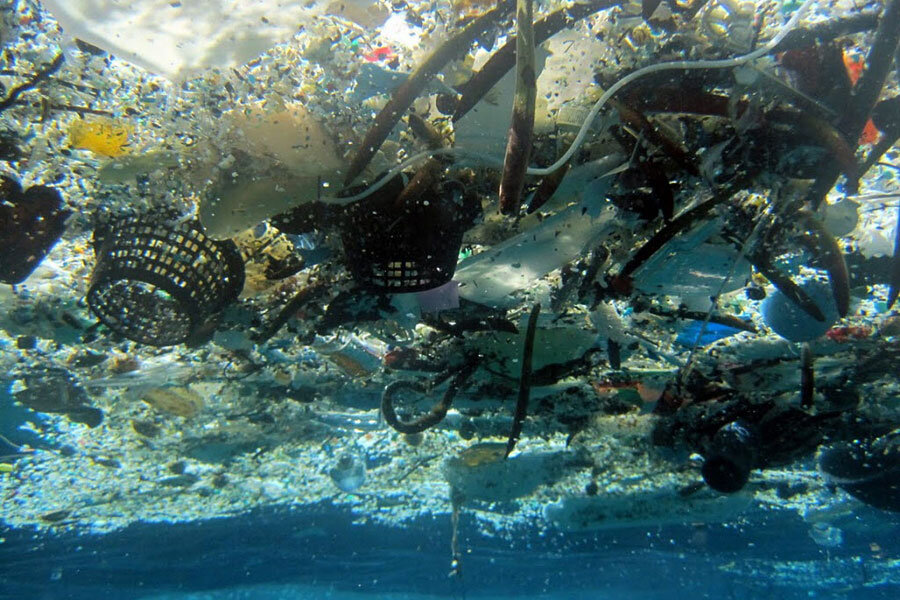Where will your message in a bottle end up? New math model offers clues.
Loading...
If you toss a message in a bottle into the ocean, instead of washing up on a distant shore, it will probably end up in one of the world's five major floating garbage patches – but which one?
By using models of ocean currents, researchers have calculated the boundaries of each section of the ocean, which can extend beyond the traditionally defined borders. In the process, they found that they can predict which garbage patch will receive a piece of plastic depending on where the litter is tossed. The research may one day pinpoint areas where wildlife interacts with the moving trash. It may also help identify the biggest plastic polluters, which contribute to garbage patches that some researchers estimate to be twice the size of Texas.
"We've redefined how one should draw the borders of the oceans," said coauthor and mathematician Gary Froyland, at University of New South Wales in Sydney, Australia. "It's more scientifically meaningful to draw the boundaries according to where the water moves as opposed to just the legal, geographical boundaries."
Though the locations of the garbage patches are already well-known, this study reveals the areas of the ocean that contribute to each patch. The study appears today in the journal Chaos.
"If you throw out your plastic on a beach somewhere in California, or somewhere in Virginia, then how does that move through the ocean and in which ocean basin will it get into?" asked Erik van Sebille, an oceanographer also at the University of New South Wales.
The five garbage patches occur in each of the north and south Atlantic, the north and south Pacific, and the middle of the Indian Ocean. The plastic comes mainly from litter, which falls off of boats, is left on beaches or washes downstream in rivers.
Though most people pictures these patches as islands of debris, they're more like a very thin soup of plastic, said Froyland. Churning waves and ultraviolet light break down the trash into tiny pieces, which are sometimes eaten by fish and other marine life. Toxic chemicals in plastics could in theory accumulate through the food chain when many smaller fish are eaten by larger fish, which are eaten by humans. But, this health risk has not been fully investigated.
Froyland and van Sebille's method uses data from an existing model of ocean currents and condenses and projects that data over 1,000 years to estimate the location of these patches in the future.
Their technique correctly identifies areas of upwelling, where warmer, less-salty water is rising, and areas of downwelling, where currents of seawater sink into a swirling gyre – a rotating system of ocean currents – creating the garbage patches.
"The plastic that they take with them towards the centers of the gyres is too buoyant – it can't sink with the water so it stays behind," said van Sebille. "It's a bit like a toilet that won't flush."
Some of the ocean regions have surprisingly complex boundaries. If you toss a bottle off the coast of Madagascar, for example, the plastic will journey to the gyre in the South Atlantic instead of being sucked into the much closer Indian Ocean patch.
Though previous papers have looked at the formation of garbage patches, the current method predicts what might happen far into the future.
"The merit of this paper is that they develop a quite mathematically rigorous method to estimate the position of the patches and also, I think more importantly, what is called the basin of attraction: the regions in the ocean where garbage can be attracted," said Emilio Garcia-Hernandez, a researcher at, the Institute for Cross-Disciplinary Physics and Complex Systems in Palma de Mallorca, Spain. He said that the method may also be useful for studies of other regions that attract matter, such as rocks in asteroid belts.
Froyland said that the method could have applications to other questions dealing with water movement and mixing. In the event of another oil spill in the Gulf of Mexico, for example, it could predict where the ocean will carry the oil so that clean-up crews could target the most affected areas.
Unfortunately for the oceans, cleaning up the garbage patches is beyond our current capabilities. The pieces of plastic are so small that to skim them from the water would also remove plankton and small animals, explained van Sebille.
"It is much more important and much more useful to stop putting plastic in the ocean in the first place," said van Sebille, because few animals live in gyres. "Most of the harm is done where most of the creatures live, and that's actually close to the coast."
In future work, van Sebille plans to use the method to spotlight areas where sea creatures interact with the garbage, because these are the areas where animals may benefit from a cleanup.
Curious where your trash ends up? The researchers created a website that lets you virtually pollute the ocean so you can see where your plastic litter will travel.
Patricia Waldron (@patriciawaldron) is a news intern at Inside Science.
Originally posted on Inside Science News Service.







